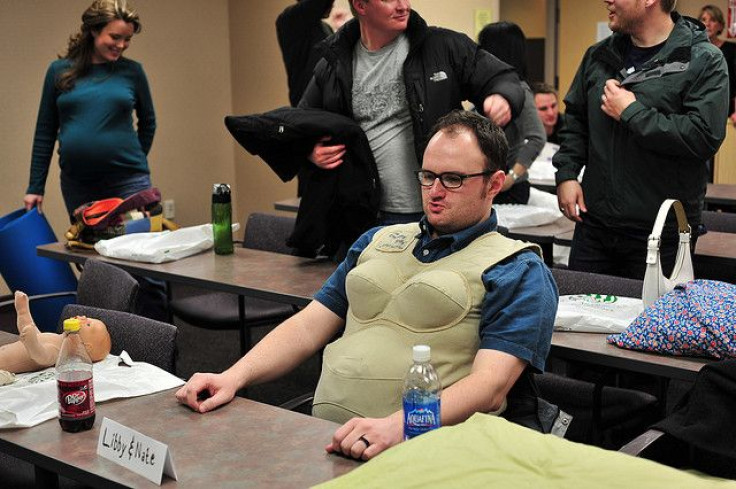What Giving Birth Feels Like: Men May Never Experience Labor, But They Can Get A Taste Of It

Ah, the miracle of childbirth. New mothers often speak of the experience as the best day of their lives. After nine hormonal, volatile months, a new life is brought into the world. The process is as old as time, but unfortunately (that’s a loose “unfortunately”) one that men will never get to experience.
But that doesn’t mean they can’t get close to finding out what giving birth feels like. Countless testimonies from new mothers and the philanthropy, or masochism, of a select group of men who have hooked themselves up to electrical stimulators, offer an accurate picture of what labor is like. Gone are the days fathers can only play the role of a squeezed, bone-crushed hand. It’s time they joined in on the fun as well.
What It’s Like
The most common analogy women draw when they talk about giving birth is that it feels like a menstrual cramp, but unfathomably more intense. This comparison, of course, is also lost on men. So male readers, if you would, consider a strange request: Become aware of your pubic bone. It sits on the midline of your body in the center of your pelvis. With that in mind, hold the awareness of your stomach as well.
Now with every shred of imagination you possess, visualize the most gut-wrenching, twisting, and piercing sense of being stabbed you can imagine. Imagine your muscles warping from the inside out, too far beneath the skin to unknot. Combine that with a brilliant pain that saps your ability to see straight and think clearly. You want to throw up, but the heaves travel downward, not up. You feel a fullness that resembles a bowel movement, but it’s unending. It doubles you over as you try to fight. But it only gets worse. Your lower back seizes up. You’re sweating, shaking.
And all at once, the pain begins to subside. The contraction is over. All that’s left is to prepare yourself for the next one. And the next one. And however many it takes for that bundle of joy to escape.
Getting In On The Action
You might think that since women have more demands put on their bodies, that they are less sensitive to pain. It turns out not to be true. A 2012 study found that men have a significantly higher pain threshold than women do. However, it may also be the case that women are simply better at coping with this pain.
A good example comes from the Dutch television show Guinea Pigs, where co-hosts Dennis Storm and Valerio Zeno hooked themselves up to electrical stimulators to simulate the pain of going through labor. "Do you think the pain will make us scream," Zeno asked before his machine is turned on. "Yes,” one of the nurses responded. “It definitely will."
The co-hosts set aside two hours for the entire ordeal — a fraction of what mothers typically go through, as it’s not uncommon for women to remain in labor for an entire day, if not longer. With four electrodes stuck to each of the hosts’ stomachs, nurses gradually dialed up the intensity of the shocks. Even the initial jolt was more than Zeno was expecting.
“This jolt he just got, what’s that expressed as a percentage?” Storm asked one of the nurses.
“It’s about two, three percent of the labor pain you can expect,” one explained, draining the color from the hosts’ faces, as Storm does the math. “So it gets 33 times as bad, right?” The co-hosts erupt in nervous laughter.
Over the next hour, Zeno and Storm change between writhing in pain on their backs, on their sides, in the fetal position, and on their stomachs — typically with their teeth gritted and fists clenched. The stimulator is contracting their muscles for them. Their insides feel like they’re ready to snap.
After an hour and five minutes, Zeno called it quits. Despite ample fussing and fighting, screaming and struggling, Storm managed to last the full two hours. A “baby” — or maybe two — was born.
What To Take Away
Men may not be able to nurse a growing fetus in their bellies, but that doesn’t mean a healthy sense of empathy can’t go a long way toward reducing mothers’ suffering. Epidurals and other remedies may lighten the load, as do C-sections. But for many expectant parents, especially mothers, a sense of comfort and the knowledge that the pain is being endured for a reason, goes even further.
“The pain of my labor came in waves, where I could feel it begin, crest, and subside,” one mother named Kathy, from Appleton, Wisc. told Parents.com.” During the crests, it was hard to remember to breathe, as it felt like my body was one big leg cramp, kind of like I was a towel being twisted and curled in half. But when it's all said and done and you're looking at your little joy, you know you'd go through it all again.”



























